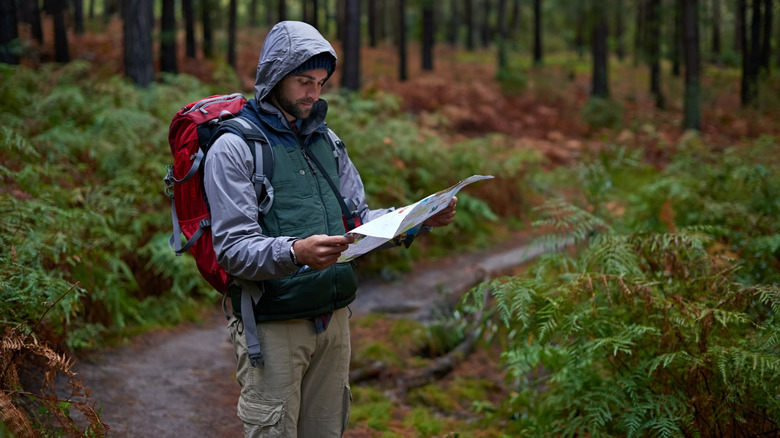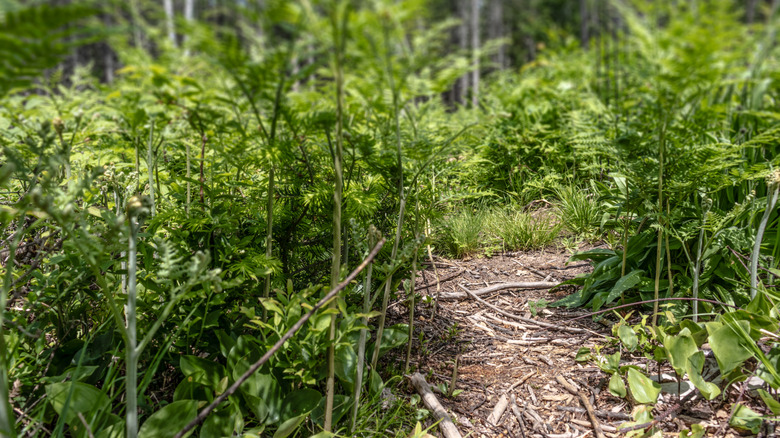Following This Kind Of Trail In The Mountains Or Forest Can Get You Very Lost Quickly
I'm lost. This realization comes with a sinking feeling, even panic. An actual shadow seems to fall over us, as we finally admit we don't know where we are, nor how to get back. This is frustrating enough in populated areas, when our GPS isn't working and we're driving around in circles, scanning the roadside for signs or people to ask. But in the woods, the problem is many times worse. We may not pass another soul. Our only resources are the things we carry on our person. Night can fall and weather can worsen. Getting truly lost in nature is cause for alarm, and turned-around hikers may not even trust the ground beneath their feet.
How can you possibly get lost, when you've been following a clear path the whole time? The answer is unsettling: The path may not be manmade. "Game trails" refer to tracks beaten down by wild animals. To casual hikers, game trails can look a lot like regular trails, especially in areas that are little traveled, poorly marked, or overgrown. There's nothing inherently dangerous about a game trail. Mammals like deer, elk, and sheep tend to clear these pathways over time, as they tread the same routes in search of food or mates. Even more imposing species like bison or bears are unlikely to bother you, unless you somehow surprise them.
What is dangerous about game trails is following them by accident. These routes don't follow human logic, and they probably won't lead anywhere you want to be. Identifying game trails is one hiking safety tip everyone should know.
Understanding game trails
How do you tell the difference between a game trail and a human trail? The clearest signs are animal tracks. You might spot a doe grazing on the edge of a hiking path, but most wild mammals go to great lengths to avoid people. Fresh paw or hoof prints in the soil are a strong indication that this trail was cleared by wildlife. Another clue is that the path looks uneven, while humans prefer flat ground and consistent surfaces. Animals can't chainsaw through fallen trees or trim branches with hedge cutters, and they won't arrange stones or logs into makeshift steps. If a trail feels narrow and patchy, better suited to a lithe, four-legged ungulate than to a booted biped, you may very well have taken a wrong turn.
Game trails can exist wherever there's wildlife, and they can confound hikers in almost any environment, from woods to prairie to desert. Many outdoorspeople can quickly identify a game trail. Naturalists are usually aware of how their favorite animals move through the wild, and hunters routinely use the trails for tracking. Like hiking paths, game trails follow popular routes, and animals save energy when they don't have to leap over fallen trees or thread their way through the underbrush. But game trails usually lead away from civilization, prioritizing the meadows, streams, and caves that animals need to survive. In the unlikely event that this game trail leads to North America's biggest predator in an agitated state, here's how to survive a bear encounter.
What to do if you're lost on a game trail
Okay, let's assume the game trail has led you astray, and you've accepted this fact. You're now lost, and you're not exactly sure how you got here. First, try to retrace your steps back to somewhere familiar. This may be as simple as following the game trail back to the regular (human, marked) path. You're unlikely to find fellow hikers on game trails, of course, so the sooner you can encounter other people, the better. If you can't solve the problem quickly, stop moving and stay calm. Take stock of your resources: How much water do you have left? Food? Are you dressed for weather? What happens if you're stranded overnight? For a comprehensive guide, here's what to do if you get lost on a hike.
This problem can happen to the best of us. In 2019, a woman named Amanda Eller got lost in the Hawaiian rainforest for 17 days before she was finally rescued. In 2025, Hadi Nazari was found after surviving 13 days in Australia's Kosciuszko National Park. In both cases, the hikers simply wandered off the right path, thinking they knew where they were going. These stories ended happily, despite the fear they felt and Eller suffering a broken leg on the fourth day, but their situations could easily have taken a turn for the worse. Many of us love to lose ourselves in nature, but in this case, it's best to take the road more traveled.


